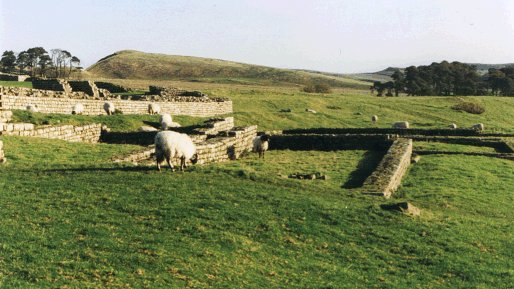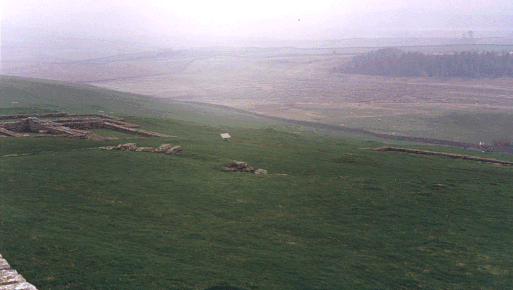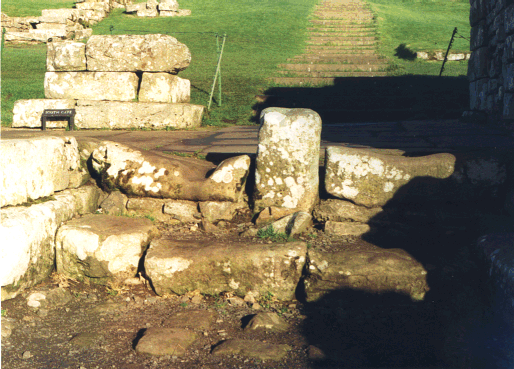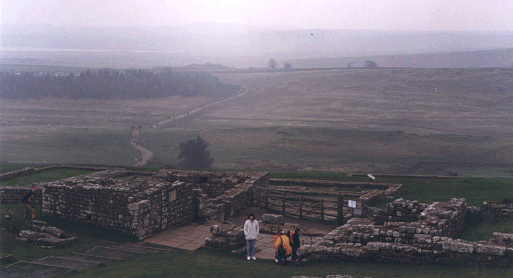
|
We start the tour outside the fort, to the south, in the vicus. The vicus was a civilian settlement that grew up around the fort in the third century AD after the area between the fort and the vallum stopped being a military zone. The spread of the vicus was also, no doubt, helped by the fact that it was now legal for Roman soldiers to marry. The house we see in front of us is particularly interesting as it was here, in 1934 during its excavation, that two bodies were found buried under the floor. One was a middle aged man, the other a girl in her late teens or early twenties. The house became known as "The Murder House" because the both bodies had been hidden under the floor at the time it was built, and the man still had a knife point sticking in his back |
�
| We now come up to an area of the vicus directly below the south gate. On your left are the remains of a tavern. This is where the garrison of the fort could come and play. Next to it (in the centre of the picture) was a shop, and behind it are two houses, one containing a furnace. Between the two houses at the back a coin mould was found for counterfeiting coins of Julia Domna during the period AD194-201 | 
|
 |
Looks grim doesn't it! This photograph, showing the view of the vicus and the valley beyond, was taken in mid April 1999 when, during my holidays, I took a trip up to the wall. All the dark or misty pictures were taken then, and I was wearing a T shirt in a temperature of about 4 or 5 degrees. The weather up by the fort is very unpredictable and can change from bright sunny and warm, to cold, wet, and even snow, in a matter of minutes. Our view of the vallum here is obscured by the drop into the valley, but opposite you can just make out farming terraces below the wood. |
| Armed by my knowledge of what the weather could be like, in mid October 1999 I went back to Housesteads. As you can see it was a bright, beautiful, and warm morning, and I ended up carrying a coat and jumper around with me that I just didn't need at all. This photograph shows the wear on the steps of the south gate. This was the right hand of two arches and was later blocked. On the left, and to the rear you can see the central piers that once supported the arched entrances. | 
|
�
 We're
now inside Vercovicium, looking down from the Praetorium to the south
gate. Just behind the gate are the remains of a seventeenth century kiln.
When the fort, along with the rest of Hadrian's Wall, lost Imperial
funding in AD407, it is probable that most of the
population moved out, possibly going to Vindolanda. Little is known of
Housesteads after the end of the the Roman occupation. In the sixteenth
century the district was renowned as a place inhabited by Reivers, or
robbers and brigands. In the eighteenth century the rule of law had again
become established, and most sculptures and inscriptions were removed. The
fort was excavated during the early nineteenth century, and again, in
various stages, throughout this century. It now has the reputation of
being the best preserved fort on Hadrian's Wall We're
now inside Vercovicium, looking down from the Praetorium to the south
gate. Just behind the gate are the remains of a seventeenth century kiln.
When the fort, along with the rest of Hadrian's Wall, lost Imperial
funding in AD407, it is probable that most of the
population moved out, possibly going to Vindolanda. Little is known of
Housesteads after the end of the the Roman occupation. In the sixteenth
century the district was renowned as a place inhabited by Reivers, or
robbers and brigands. In the eighteenth century the rule of law had again
become established, and most sculptures and inscriptions were removed. The
fort was excavated during the early nineteenth century, and again, in
various stages, throughout this century. It now has the reputation of
being the best preserved fort on Hadrian's Wall |